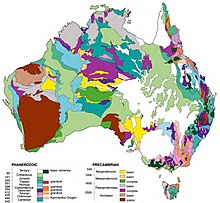Australia is a country, an island, and a continent. It is located in Oceania between the Indian Ocean and the South Pacific Ocean at 27°S 144°E / 27°S 144°E / -27; 144. It is the sixth largest country in the world with a total area of 7,686,850 square kilometres (2,967,909 sq. mi) (including Lord Howe Island and Macquarie Island), making it slightly smaller than the contiguous 48 states of the United States and 31.5 times larger than the United Kingdom.
The Australian mainland has a total coastline length of 35,876 km (22,292 mi) with an additional 23,859 km (14,825 mi) of island coastlines.[1] There are 758 estuaries around the country with most located in the tropical and sub-tropical zones.[2] Australia claims an extensive Exclusive Economic Zone of 8,148,250 square kilometres (3,146,057 sq. mi). This exclusive economic zone does not include the Australian Antarctic Territory. Australia has the largest area of ocean jurisdiction of any country on earth.[3] It has no land borders. The northernmost points of the country are the Cape York Peninsula of Queensland and the Top End of the Northern Territory.
The western half of Australia consists of the Western Plateau, which rises to mountain heights near the west coast and falls to lower elevations near the continental center. The Western Plateau region is generally flat, though broken by various mountain ranges such as the Hamersley Range, the MacDonnell Ranges, and the Musgrave Range. Surface water is generally lacking in the Western Plateau, although there are several larger rivers in the west and north, such as the Murchison, Ashburton, and Victoria river.
The Eastern Highlands, or Great Dividing Range, lie near the eastern coast of Australia, separating the relatively narrow eastern coastal plain from the rest of the continent. These Eastern Australian temperate forests have the greatest relief, the most rainfall, the most abundant and varied flora and fauna, and the densest human settlement.
Between the Eastern Highlands and the Western Plateau lie the Central Lowlands, which are made up of the Great Artesian Basin and Australia's largest river systems, Murray-Darling Basin and Lake Eyre Basin.
Off the eastern coast of Australia is the world's largest coral reef complex, the Great Barrier Reef. The State of Tasmania, a large and mountainous island, resides in the south-eastern corner of Australia.
[edit] Geology
Main article: Geology of Australia
Australia is the lowest, flattest, and oldest continental landmass on Earth[citation needed] and it has had a relatively stable geological history. Geological forces such as tectonic uplift of mountain ranges or clashes between tectonic plates occurred mainly in Australia's early history, when it was still a part of Gondwana. Its highest peak is Mount Kosciuszko at 2,228 metres (7,310 ft), which is relatively low in comparison to the highest mountains on other continents. Erosion has heavily weathered Australia's surface.
by Arnold
source: www.wikipedia.de
source: www.wikipedia.de







